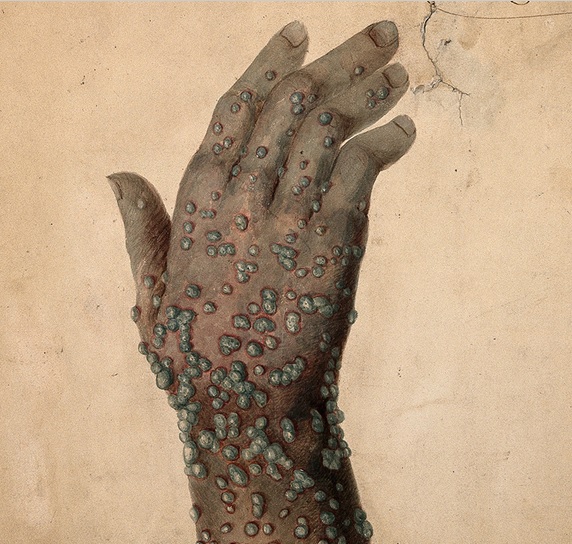About a year after the arrival of the First Fleet in Sydney a major smallpox epidemic broke out. However, it did not affect the British colonists, most of who had been exposed to the disease during their infancy.
As a result, smallpox was not detected until members of the Aboriginal communities living between Sydney Cove and the Heads were found. According to Newton Fowell, ‘lying dead on the Beaches and in the Caverns of Rocks’. They were, ‘generally found with the remains of a Small Fire on each Side of them and some Water left within their Reach’.
Without previous exposure to the smallpox virus, Aboriginal people had no resistance, and up to 70 per cent were killed by the disease. (1)
Smallpox had a devastating effect upon the Indigenous population which can be seen in the accounts of two squatters on the Murray River. One of these, Peter Beveridge, formed Tyntynder station near Swan Hill in 1845 and acquired an extensive knowledge of the Aboriginal people of the area. He wrote that amongst Aboriginal people, ‘there seems to be a perfect absence of diseases.’ However, he noticed the pock-marked complexion of some of the Elders and knew at some time previous, smallpox had been prevalent. (2)
He questioned the Elders who remembered the epidemic, ‘to this day the old men speak of it shudderingly, and with such an amount of loathing horror’. (2)
The Elders told him, ‘they took care of the sick during the early stages of the epidemic but when the death rate became too high and the panic so great that burying the bodies was not even attempted. The survivors merely moved their camps daily leaving the sick to die and soon the air was filled with the fetid odors arising from the decomposing bodies. The people began to think no one would escape death and became numb awaiting their fate’. Beveridge noted, ‘the small-pox epidemic seems to be the only occasion in their stories where great numbers of their people died’. (2)
A neighbour, Edward Micklethwaite Curr, had a station on the Murray River bordered by the Campaspe and Goulburn Rivers. He was also a keen observer of Aboriginal people and wrote, ‘the effect of Smallpox on indigenous people was catastrophic.’ (3)
He noticed the numbers of Aboriginal people were too few compared to the large number of earth ovens in the area. He said these ovens, ‘far exceeded the number of people who could have used them’. This made him certain a great many people had died in an epidemic. (3)
His neighbour, Peter Beveridge noted, ‘Aboriginal skeletons are frequently discovered in cooking mounds…We once dug out an oven and found it contained three thousand cubic yards of soil…During its removal, we exhumed twenty-eight skeletons.’ (2)
Curious as to how these people had died, he, ‘made inquiry among the very old people and discovered they were the remains of some of the smallpox victims who had died during the earlier epidemic.’ (2)
Nowadays, we understand the debilitating effects of PTSD in people who have experienced or witnessed a traumatic event and can easily imagine how numb and lost the survivors felt.
Traditional life would have been almost impossible for Aboriginal people in the first few years after the epidemic. Fewer people to care for country would have placed an enormous burden upon those left to carry on. Fish traps need repair after winter floods and nets and tools all require attention to keep ready for use. Even so, Aboriginal people regrouped and by the time the first white squatters came to their lands in north-east Victoria they were once again a strong and resourceful people.
Peter Beveridge believed the smallpox epidemic came from Sydney about 50 years before his arrival. He knew historically of its spread but by discussions with Elders and noting the scars they bore he decided it was about fifty years previous. (2)
Edward Micklethwaite Curr supported this assertion by using the growth of young trees sprouting from the old earth ovens. He estimated by the girth and height of the trees they were about fifty years old which placed the epidemic around 1879-80, the exact date of the outbreak that arrived with the first fleet. (3)
THE REFERENCES;
* Image; A rash of pustules on the hand of a patient probably suffering from smallpox in an 1831 watercolour by R. Carswell. (Image: Wellcome Collection under the 4.0 International Creative Commons license)
- Information on smallpox and First Fleet, https://www.nma.gov.au/defining-moments/resources/smallpox-epidemic
- Peter Beveridge, The Aborigines of Victoria & Riverina, 1889, pg 14-15 & pg36-37
- Edward Micklethwaite Curr, Recollections of Squatting in Victoria. Pg 236 & 237


